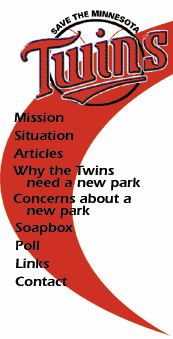Mention stadium subsidies to many legislators and they'll scrunch their noses and walk
away. Mention the latest Twins proposal for a no-interest loan to help fund a
ballpark, however, and they at least appear willing to stay in the same room.
While the pitch has helped the Minnesota Twins gain momentum -- and there is the
precedent of the $48 million loan used to build Xcel Energy Center in St. Paul -- make no
mistake: A $150 million no-interest loan to the Twins still would be a state subsidy.
A loan could save Twins owner Carl Pohlad millions each year in finance charges while
also potentially costing the state millions more in interest earnings on money it could
otherwise have invested.
"There certainly is a value to the money," said Jim Paulsen, chief investment
officer of Wells Capital Management. "That's the bottom line."
Several local financial experts said it's hard to predict what Pohlad would have to pay
if he went out on the open market for financing to match his $150 million investment.
Questions about how the payments would be guaranteed -- through team revenues, using the
stadium as collateral and so on -- make pinning down an interest rate difficult.
But assuming that Pohlad would qualify for the prime rate that banks charge their best
customers, currently 8.5 percent, finance charges alone could cost $12.75 million a year.
Over the life of the loan, Pohlad could save as much as $255 million with a no-cost loan
from the state.
Lost income
Considering that the state would probably make the loan from the general fund -- which
is what it did for the Wild arena -- there would be what is called an "opportunity
cost" to the money. That's what the state could make on the $150 million if it were
to invest the money in securities or bonds instead of lending it to the Twins.
Assuming a 6 percent return on investment, which state finance officials said is
reasonable, $150 million has the potential to earn the state $9 million a year -- or $180
million over 20 years. Using the same 6 percent assumption, the money used to make the
hockey arena loan could have earned about $2.9 million a year.
But few hockey fans or legislators now would argue that the Wild investment isn't
paying other kinds of dividends.
The team has agreed to pay $3.5 million a year in rent over its 25-year lease with the
city, plus payments in lieu of property taxes ranging from $2.5 million in 2000 to $6
million in 2025.
Plus, St. Paul officials point to the economic development and energy that has come to
downtown with the more than 18,000 fans who have attended every Wild home game so far.
Paulsen said that value shouldn't be ignored when computing the payoff of a no-interest
loan for the Twins.
"There's an opportunity cost to money. There's no free money," Paulsen said.
"On the other hand, there's an external benefit to the city and the state to having a
well-funded, well-operated major league team."



